Mobile app performance is critical in 2025, with over 70% of users abandoning apps that take more than 3 seconds to load. Application Performance Monitoring (APM) tools help developers track, analyze, and optimize app performance in real-time, ensuring smooth user experiences and reducing issues like crashes, slow load times, and high resource usage. Below are 10 top APM tools for mobile apps, each offering distinct features, platform support, and pricing models:
- BrowserStack: Real device testing on 3,500+ devices with real-time monitoring. Starts at $39/month.
- Appium: Open-source UI automation for Android, iOS, and Windows. Free.
- New Relic Mobile: Enterprise-grade monitoring with crash analytics and user interaction tracking. Starts at $49/user/month.
- Firebase Performance Monitoring: Free tool from Google for real-time performance insights and custom traces.
- AppDynamics: Advanced analytics for mobile apps, crash rates, and user journeys. Pricing starts at $60/month per CPU core.
- TestFairy: Combines performance metrics with video session recordings. Starts at $49/month.
- SolarWinds AppOptics: Backend and infrastructure monitoring with customizable dashboards. Starts at $9.99/host/month.
- Android Profiler: Free built-in Android Studio tool for CPU, memory, and network profiling.
- LeakCanary: Free Android memory leak detection tool by Square.
- BlazeMeter: Cloud-based load testing for mobile apps, starting at $99/month.
Quick Comparison:
| Tool | Platform Support | Key Features | Starting Price (USD) |
|---|---|---|---|
| BrowserStack | iOS, Android | Real device testing, session replays | $39/month |
| Appium | iOS, Android, Windows | Cross-platform UI automation | Free |
| New Relic Mobile | iOS, Android | Real-time monitoring, crash analytics | $49/user/month |
| Firebase | iOS, Android, Flutter | Free real-user performance insights | Free |
| AppDynamics | iOS, Android | End-to-end monitoring, AI-driven analytics | $60/month per core |
| TestFairy | iOS, Android | Video session recordings | $49/month |
| SolarWinds | Backend only | Infrastructure monitoring, tracing | $9.99/host/month |
| Android Profiler | Android only | CPU, memory, network profiling | Free |
| LeakCanary | Android only | Memory leak detection | Free |
| BlazeMeter | iOS, Android, Web | Load testing, JMeter-based | $99/month |
Each tool suits different needs, from free solutions like Firebase and LeakCanary to enterprise-focused platforms like AppDynamics. Choose based on your app's complexity, platform, and budget.
The Next Wave of APM Is Mobile
1. BrowserStack
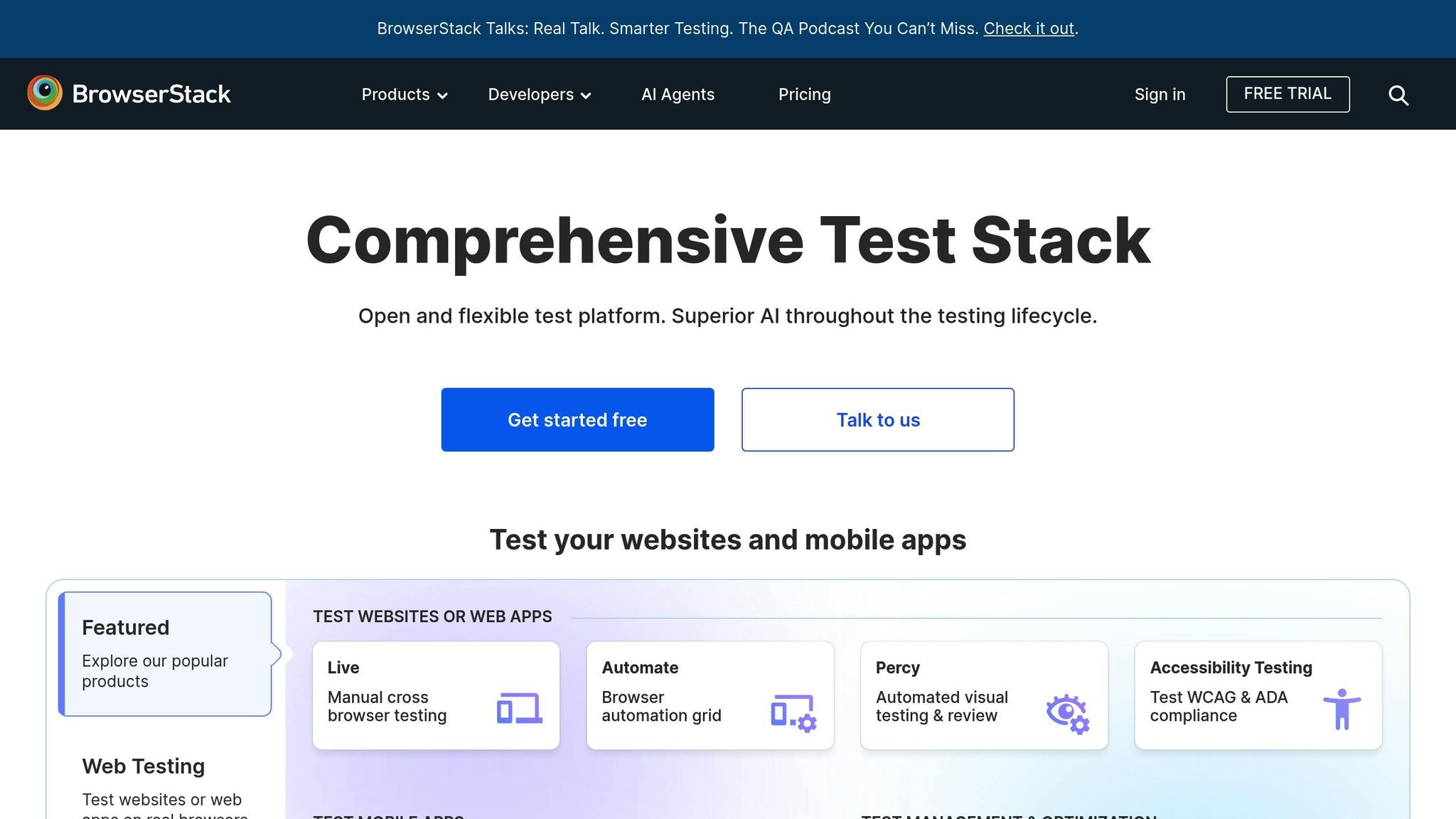
BrowserStack is a cloud-based platform designed to test mobile app performance using 3,500+ real devices and browsers for both iOS and Android. Unlike traditional methods that depend on emulators, BrowserStack provides real device environments, offering a more accurate representation of actual user conditions.
The platform includes three primary tools tailored to different testing needs: App Live for manual testing, App Automate for running automated workflows, and App Performance for tracking app performance metrics.
Platform Support (iOS, Android, Cross-Platform)
BrowserStack supports testing on both iOS and Android devices, covering a wide range of operating system versions. By utilizing this extensive real device cloud, teams can avoid the hassle of maintaining physical device labs. This makes scaling testing efforts far more efficient and allows seamless integration with the platform's advanced performance features.
Core Features (Real-Time Monitoring, Crash Analytics, User Experience Tracking)
BrowserStack offers real-time monitoring to capture key metrics like FPS, ANR rates, loading times, and resource usage across its 3,500+ devices. Features such as session replays, detailed graphs, and audit reports provide teams with actionable insights into performance issues. Additionally, the platform allows developers to simulate various network conditions, helping them optimize app performance for scenarios like low bandwidth or high latency environments.
Integration Capabilities and Pricing
BrowserStack integrates smoothly with CI/CD tools such as Jenkins, Travis CI, and CircleCI, as well as test automation frameworks like Appium and Selenium. This integration streamlines the testing process, making it easier to incorporate into existing development workflows.
Pricing for BrowserStack follows a subscription model, starting at $39 per month for individual users. Larger teams can opt for business or enterprise plans, and organizations with specific needs or high testing volumes can request custom pricing. All prices are listed in U.S. dollars, adhering to standard American billing conventions.
A fintech company in the U.S. used BrowserStack to test their mobile banking app on multiple real devices and under various network conditions. Through the platform's real-time monitoring and crash analytics, they identified a memory leak on older Android devices and UI lag issues on iOS 14. After resolving these problems, the company achieved a 30% drop in crash rates, leading to higher user satisfaction and showcasing the platform's practical benefits.
2. Appium
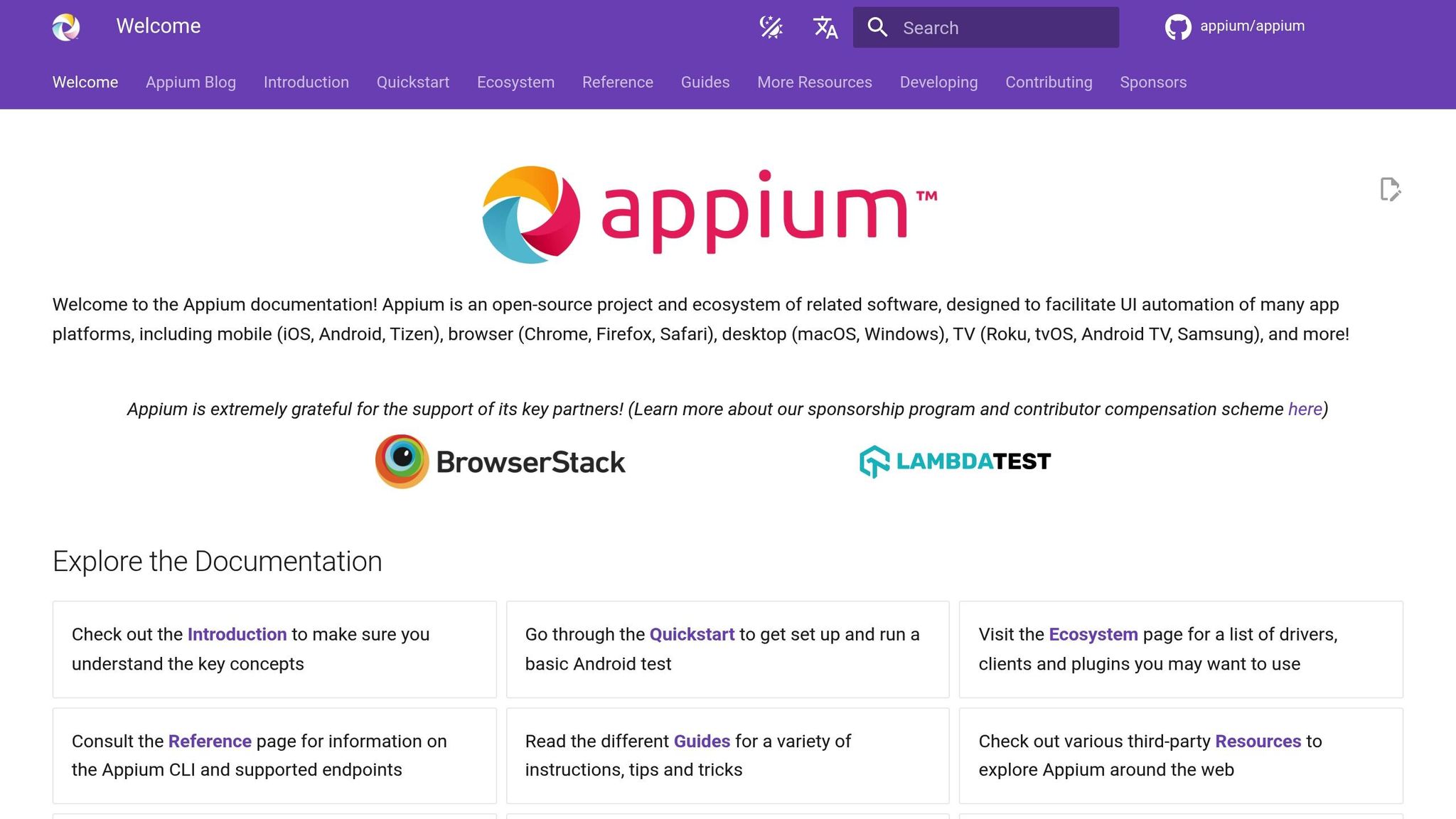
Appium is an open-source framework designed to automate testing for native, hybrid, and mobile web apps across multiple platforms.
Platform Support
Appium supports Android, iOS, and Windows, making it a versatile choice for cross-platform testing. You can write test scripts in popular programming languages like Java, Python, JavaScript, or Ruby, and these scripts can run seamlessly across all supported platforms. Whether you're using real devices or emulators/simulators, Appium provides the flexibility to suit different budgets and testing needs.
Core Features
Appium specializes in automating UI interactions such as taps, swipes, and screen transitions, while also measuring response times. Although its primary focus is on UI automation and performance measurement, you can expand its functionality with tools like Firebase Crashlytics or Sentry for broader performance insights.
Integration Capabilities
Appium easily integrates into CI/CD pipelines using tools like Jenkins, GitHub Actions, and Bitrise. It supports the WebDriver protocol, ensuring compatibility with cloud-based device testing platforms like BrowserStack and Sauce Labs. These integrations help streamline your testing process and improve overall test coverage.
Pricing
Appium is completely free and open-source, meaning there are no licensing fees. However, you may incur costs for infrastructure, such as setting up device labs or using cloud testing services. Despite this, Appium remains a budget-friendly option for teams of all sizes.
3. New Relic Mobile
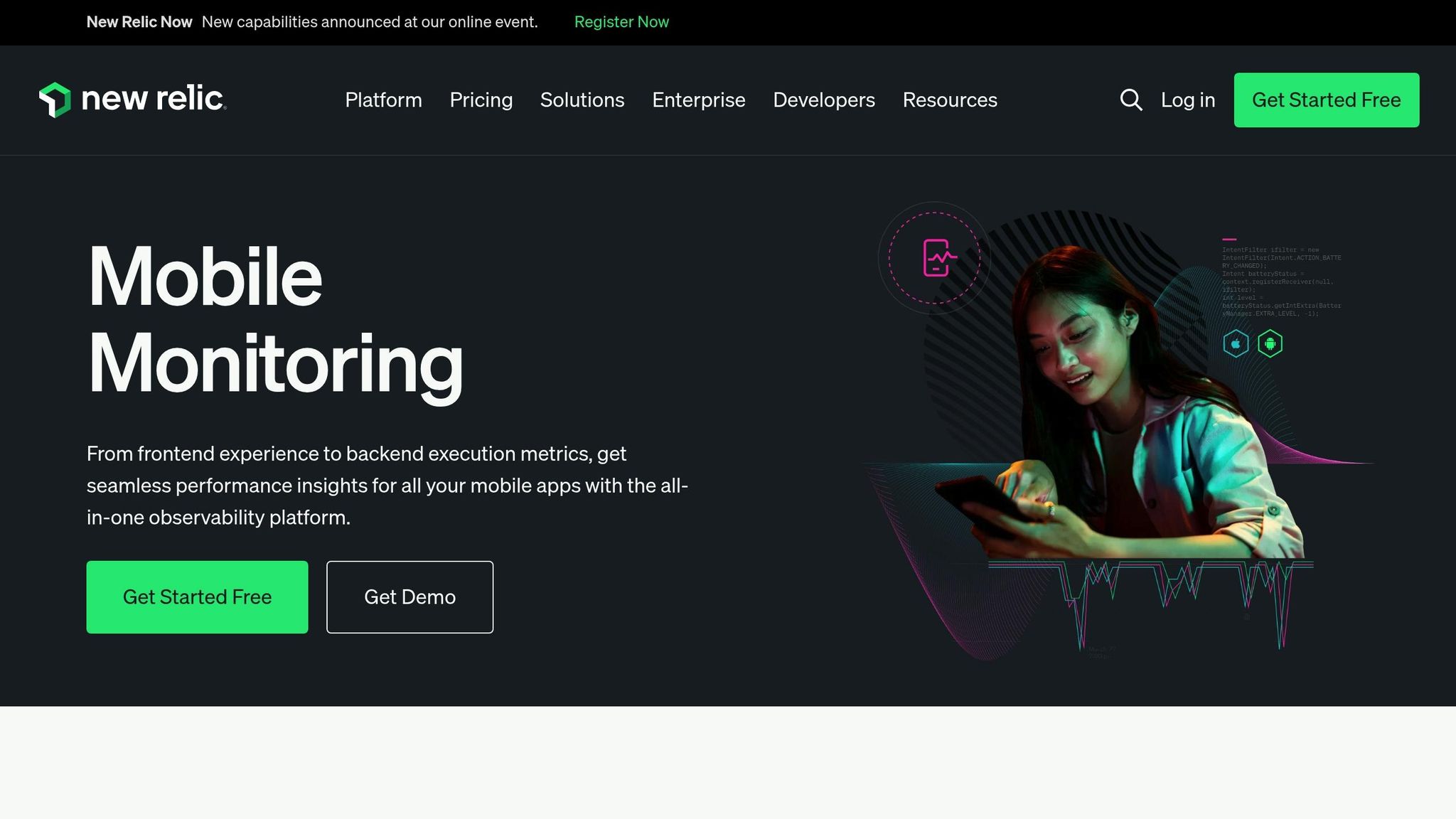
New Relic Mobile delivers enterprise-level monitoring for mobile apps, providing real-time analytics and in-depth performance insights to help developers maintain high standards.
Platform Support
This tool works seamlessly with both iOS and Android platforms. It also supports cross-platform frameworks like React Native, ensuring that no matter your development approach, you can consistently monitor your entire mobile app portfolio.
Core Features
New Relic Mobile offers real-time tracking for crash rates, error rates, user interactions, and network response times. Its detailed crash analytics help developers quickly pinpoint and address root causes. Additionally, user experience tracking gathers metrics that reveal how users interact with the app under real-world conditions. This data allows teams to fine-tune responsiveness and eliminate performance bottlenecks.
Integration Capabilities
The platform integrates smoothly with the broader New Relic suite, providing a unified view of both mobile and backend performance. This integration connects mobile app issues to potential server-side problems, offering a complete picture of the application ecosystem. It also supports CI/CD pipeline integration, automating performance monitoring throughout development and deployment. With connections to alerting and incident management tools, teams can proactively address potential issues before they escalate.
Pricing
New Relic provides a free tier, ideal for small teams or initial testing, though it comes with limited data retention and features. Paid plans begin at approximately $49 per user per month, with pricing adjusted based on data retention, the features included, and the number of users. For larger organizations with complex monitoring needs, custom enterprise pricing is available upon request.
4. Firebase Performance Monitoring
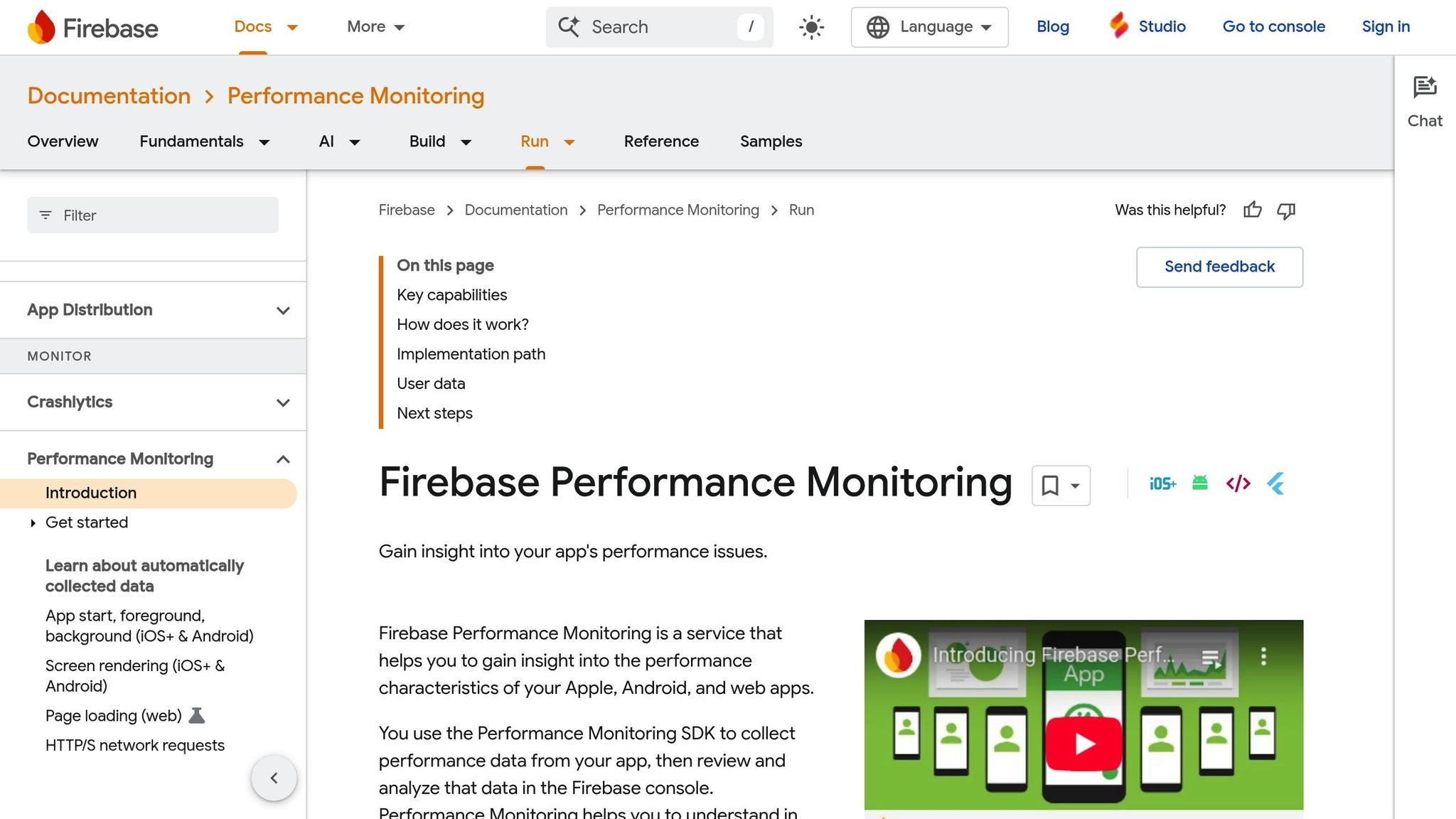
Firebase Performance Monitoring is a free application performance management (APM) tool from Google, designed specifically for mobile apps. It offers real-time insights into how apps perform based on actual user interactions, helping developers identify and address performance issues under real-world conditions.
Platform Support
This tool works seamlessly across major mobile platforms, including iOS, Android, and widely-used cross-platform frameworks like Flutter and React Native. With this compatibility, developers can monitor performance across various apps with a single, unified approach.
Core Features
Firebase Performance Monitoring collects essential performance metrics automatically, such as:
- App startup time
- Network request latency
- Screen rendering performance
Its real-time monitoring and customizable traces make it easy to pinpoint issues like slow startups, high latency, frozen frames, or delayed rendering. Developers are notified of these issues directly through the Firebase Console, enabling swift action. Additionally, the tool integrates with Firebase Crashlytics, combining performance and crash data for a more complete view of app health.
Integration Capabilities
Integrating Firebase Performance Monitoring is straightforward with the Firebase SDK. The tool works natively with other Firebase services, such as Analytics, Remote Config, and Crashlytics, creating a cohesive ecosystem for mobile app development. For teams needing deeper analysis, performance data can be exported to BigQuery for long-term tracking and custom reporting. Its compatibility with cross-platform frameworks ensures consistent monitoring, no matter the development approach.
Pricing
Firebase Performance Monitoring is available at no cost as part of the Firebase platform. However, exporting large amounts of data to BigQuery or using other paid Firebase services may incur additional fees. Pricing is handled in USD, making it easier for U.S. developers to manage budgets effectively.
5. AppDynamics
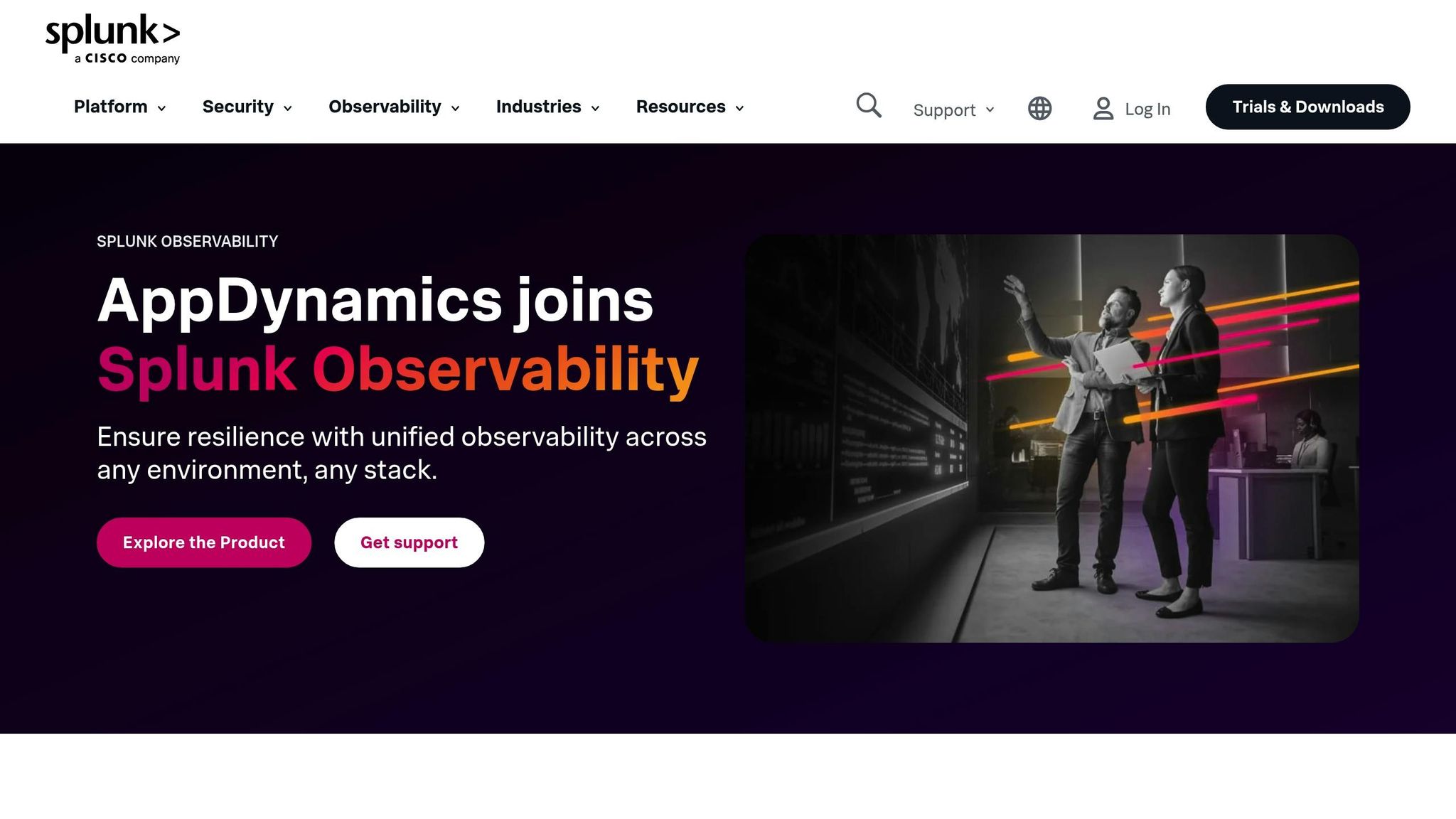
AppDynamics is a powerful enterprise-level APM solution that provides detailed insights into mobile app performance while ensuring strong security and reliable support. As part of Cisco's portfolio, it’s a trusted option for organizations managing complex mobile ecosystems.
Platform Support
AppDynamics offers comprehensive monitoring for both iOS and Android platforms, covering native and hybrid mobile apps. Its ability to handle cross-platform monitoring ensures that organizations can manage their apps across multiple operating systems in a unified way. This makes it particularly useful for enterprises that need consistent oversight across diverse mobile environments.
Core Features
The platform delivers real-time performance monitoring, detailed crash analytics with stack traces, and Experience Journey Mapping to help teams visualize user flows. These tools make it easier to identify and address performance issues before they affect users.
AppDynamics tracks essential metrics such as:
- App launch times
- Crash frequency
- Error rates
- Session durations
- Network latency
- Response times
These metrics allow developers to pinpoint bottlenecks and focus on fixes that improve user retention and business outcomes.
The platform also leverages AI-driven analytics to automatically flag anomalies and performance issues. This reduces the need for manual monitoring and cuts down mean time to resolution (MTTR) for mobile incidents by up to 70%. Its alerting and root cause analysis features are particularly effective for minimizing downtime.
For example, a leading retail company used AppDynamics to monitor its mobile shopping app. During peak sales events, they identified a spike in crash rates, traced the issue to a memory leak in the checkout process, and deployed a fix. This reduced crash rates by 40%, boosting user satisfaction and sales conversions.
Additionally, AppDynamics integrates seamlessly with IT and DevOps tools, enhancing its usability across teams.
Integration Capabilities
AppDynamics works with CI/CD pipelines and major cloud platforms like AWS and Azure. These integrations allow for smooth data sharing and workflow automation, helping teams correlate app performance with infrastructure metrics.
Its end-to-end transaction tracing feature is especially valuable, as it enables developers to follow a user’s journey through the app and backend services. This capability is crucial for troubleshooting and optimizing user experiences in complex environments.
Pricing
AppDynamics uses a subscription-based pricing model, billed in U.S. dollars (USD). Costs vary depending on factors like the number of mobile agents, desired features, and deployment scale. As of 2025, detailed pricing is available upon request, with enterprise plans tailored to specific needs. U.S. customers can choose between monthly or annual billing.
While AppDynamics offers an impressive range of features, organizations should be aware that setup and configuration can be complex, especially for large-scale or multi-platform deployments. Despite this, the platform consistently earns high ratings (4.5/5 or higher) on major review sites for its ability to deliver actionable insights. Some users note that training may be necessary to fully utilize its advanced analytics and integrations.
6. TestFairy
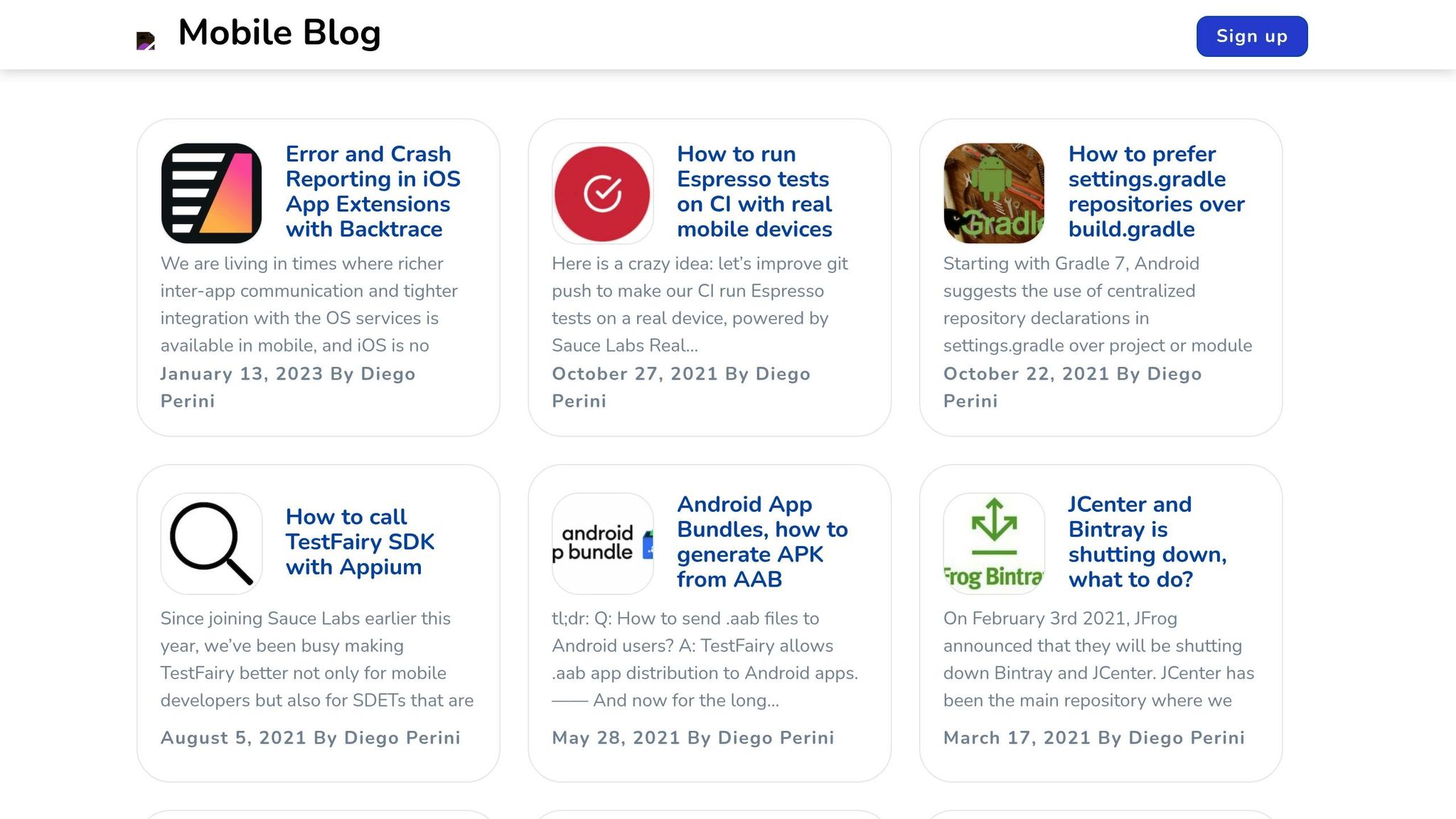
TestFairy stands out by combining traditional performance tracking with visual session recordings, offering teams detailed insights into user interactions.
Platform Support
TestFairy works with both iOS and Android, making it a solid choice for teams focused on native app development. While it's not specifically designed for frameworks like React Native or Flutter, it can still be integrated into hybrid app workflows with some adjustments.
Core Features
What makes TestFairy special is its ability to provide visual insights alongside performance metrics. It records video sessions of user interactions, capturing what happens just before a crash. This feature simplifies the process of reproducing and diagnosing bugs by showing exactly how users interact with the app in real time.
In addition to session recordings, TestFairy tracks performance metrics and links crashes to session details. This connection helps teams understand the conditions that led to a crash, offering context that traditional tools often miss. By turning raw data into actionable feedback, TestFairy helps teams focus on improving app performance.
Integration Capabilities
TestFairy integrates seamlessly with tools like Jira, Slack, and CI/CD pipelines, making it easy to fit into existing development workflows. For instance:
- Crash reports and test results can be sent directly to Slack, keeping teams updated in real time.
- The Jira integration allows automatic creation of bug tickets, speeding up issue tracking and resolution.
These integrations ensure that TestFairy supports smooth communication and efficient feedback collection.
Pricing
TestFairy offers a tiered pricing structure in USD, with plans based on the number of apps, users, or sessions being monitored. A free trial or limited free tier is often available, making it accessible for small teams or those evaluating the tool. For exact pricing and enterprise options, teams need to contact TestFairy for a customized quote.
QA teams and smaller development groups appreciate TestFairy for its ease of use and the clarity of its insights. While its analytics might not be as extensive as tools tailored for large enterprises, most users find it easy to integrate with standard iOS and Android projects. It’s a practical choice for organizations aiming to improve mobile app performance monitoring without a complicated setup.
sbb-itb-8abf120
7. SolarWinds AppOptics
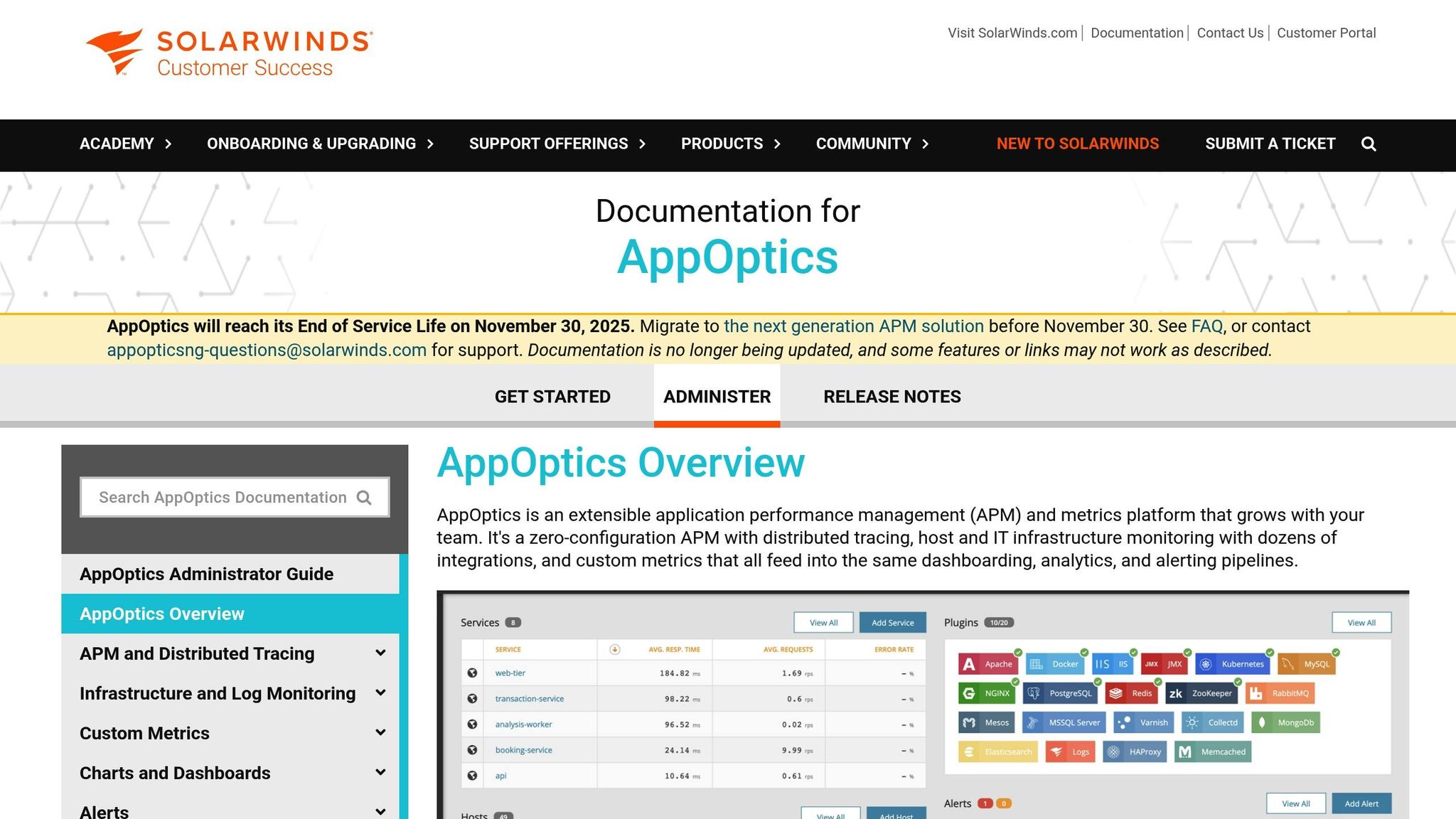
SolarWinds AppOptics provides a full-stack monitoring solution for mobile apps, focusing primarily on the backend services, APIs, and infrastructure that power these applications. Instead of diving into in-app performance, it emphasizes monitoring the systems behind the scenes, making it a great complement to tools that handle in-app metrics.
Platform Support
While AppOptics doesn't offer native SDKs for direct in-app tracking, it excels at monitoring backend services and APIs for iOS, Android, and web applications. By integrating with Pingdom, it delivers a complete view of the user experience, from the backend to the front end.
Core Features
AppOptics stands out with tools like distributed tracing, live code profiling, and customizable dashboards, all designed to identify performance issues in microservices and app backends. Its real-time data feeds, exception tracking, and centralized log analysis make it easier to link mobile issues to backend problems. Developers can also use its custom metrics feature to create dashboards tailored to specific app performance indicators.
For example, a U.S. healthcare provider used distributed tracing in AppOptics to uncover and resolve latency issues caused by a particular database query. This fix improved app speed and boosted patient satisfaction.
Integration Capabilities
AppOptics goes beyond backend monitoring by integrating seamlessly with major cloud providers and DevOps tools. It works natively with AWS, Azure, and Google Cloud and supports popular DevOps tools and CI/CD pipelines. Additionally, its API-based integrations allow for custom workflows and reports, ensuring a unified view of app performance across both client-side and backend systems.
Pricing
SolarWinds AppOptics uses a subscription-based pricing model in U.S. dollars. Infrastructure monitoring starts at about $9.99 per host per month, while full application performance monitoring (APM) capabilities are available at approximately $24.99 per host per month. Pricing adjusts based on the number of hosts and features needed, making it suitable for both small teams and large enterprises. The tool has earned a user rating of around 4.3/5 on major software review platforms.
8. Android Profiler (Android Studio)
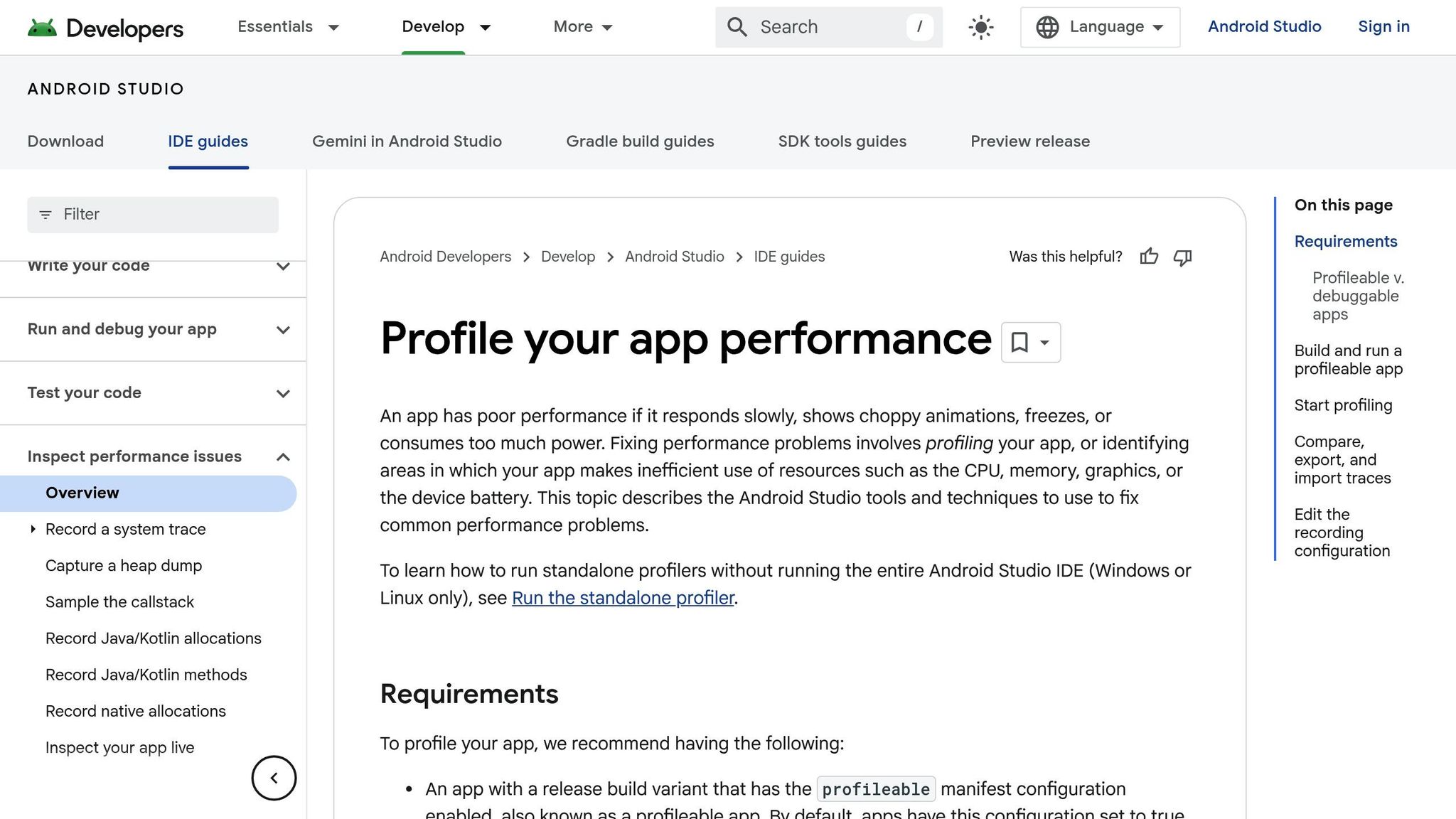
Android Profiler is a built-in performance monitoring tool in Android Studio, tailored specifically for developers. Unlike cloud-based Application Performance Monitoring (APM) tools, it provides real-time performance insights during the development phase. This allows teams to identify and address performance issues long before the app reaches production.
Platform Support
Android Profiler is exclusively designed for Android app development and is seamlessly integrated into Android Studio. Its Android-specific focus enables it to deliver detailed, native-level performance data, making it an indispensable tool for Android developers.
Core Features
This tool provides real-time monitoring of key performance metrics, including:
- CPU usage: Track how much processing power your app consumes.
- Memory consumption: Identify memory leaks and optimize memory usage.
- Network activity: Monitor data transfer rates and detect network spikes.
- Battery usage: Analyze how your app impacts battery life.
Additionally, it helps developers pinpoint issues like slow method calls, rendering delays, and other bottlenecks on devices and emulators. Features like session recording and APK debugging streamline the optimization process, though it lacks dedicated crash analytics tools like Firebase Crashlytics.
Integration Capabilities
As part of Android Studio, Android Profiler fits seamlessly into the development workflow. Developers can move between writing code and profiling performance without leaving their Integrated Development Environment (IDE). It works with all Android projects, supporting both debug and release builds.
For teams using Firebase, Android Profiler complements Firebase Performance Monitoring by focusing on development-time optimization. Firebase handles monitoring in the production environment, creating a well-rounded performance strategy.
Pricing
Android Profiler is included with Android Studio, making it a free, professional-grade tool for performance monitoring.
9. LeakCanary
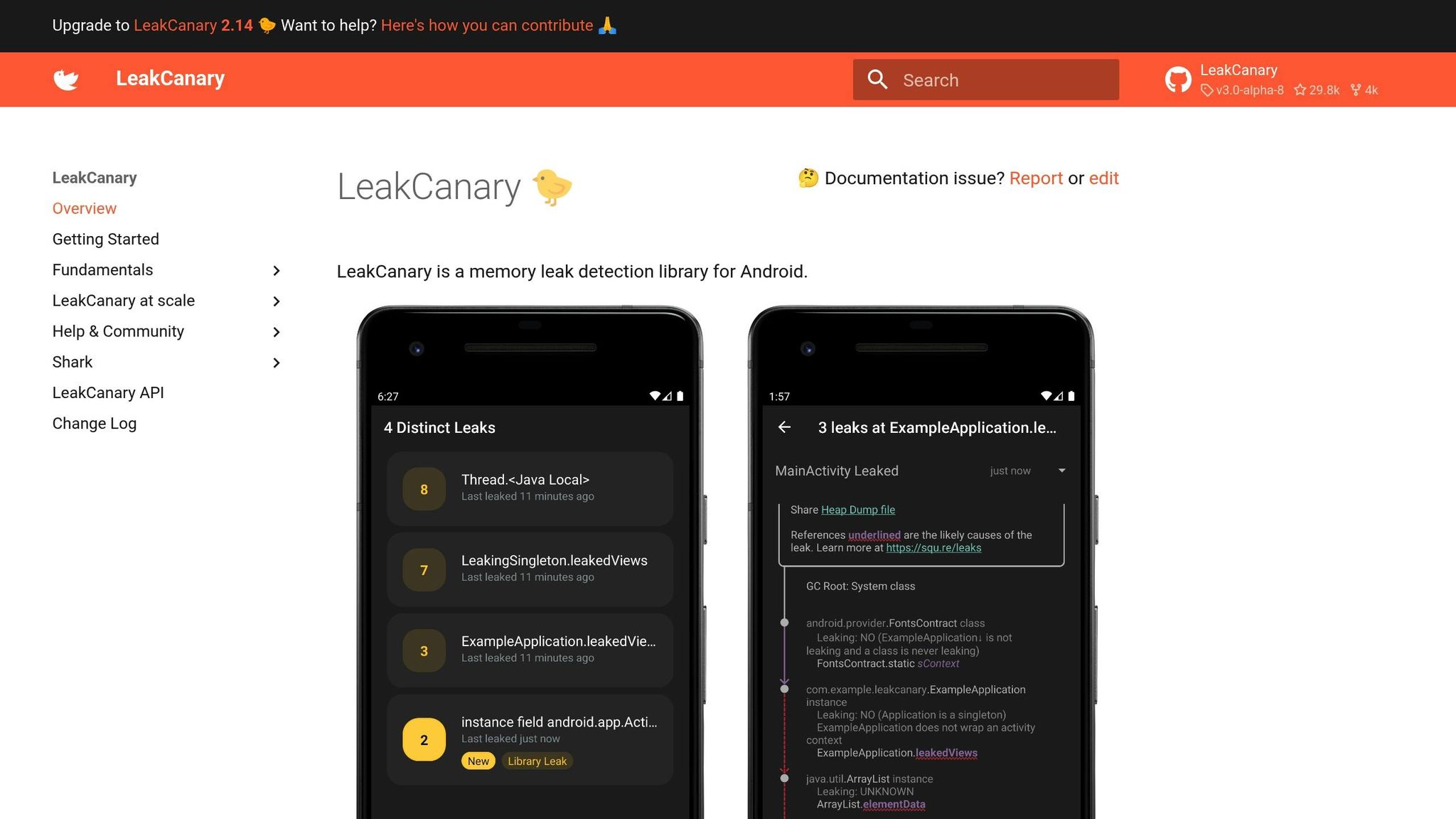
LeakCanary is a specialized tool built by Square (now Block, Inc.) to detect memory leaks in Android apps. Unlike broader performance monitoring tools, LeakCanary zeroes in on memory leaks that can cause crashes or slow performance, making it a go-to resource for Android developers looking to fine-tune their apps.
Platform Support
This tool is exclusively designed for Android apps. It doesn't extend support to iOS or cross-platform frameworks, a limitation that allows it to focus on providing in-depth insights into Android-specific memory management issues.
Core Features
LeakCanary stands out for its ability to automatically detect memory leaks in real time during development and testing. After being integrated, it monitors your app’s memory usage and flags instances where objects that should be garbage collected are still lingering. It provides detailed reports that highlight the leaking objects and the reference chains causing the issue. This level of detail helps developers quickly identify and fix potential problems before they reach production.
Integration Capabilities
Adding LeakCanary to your project is simple. You just include it as a library dependency in your Android project's build.gradle file. Once included, it starts monitoring memory leaks automatically with minimal setup required. Many developers pair it with tools like Firebase Performance Monitoring or Android Profiler for a more comprehensive performance analysis.
Pricing
LeakCanary is completely free to use. As an open-source tool, it has no licensing fees, making it accessible for both commercial and personal projects.
10. BlazeMeter
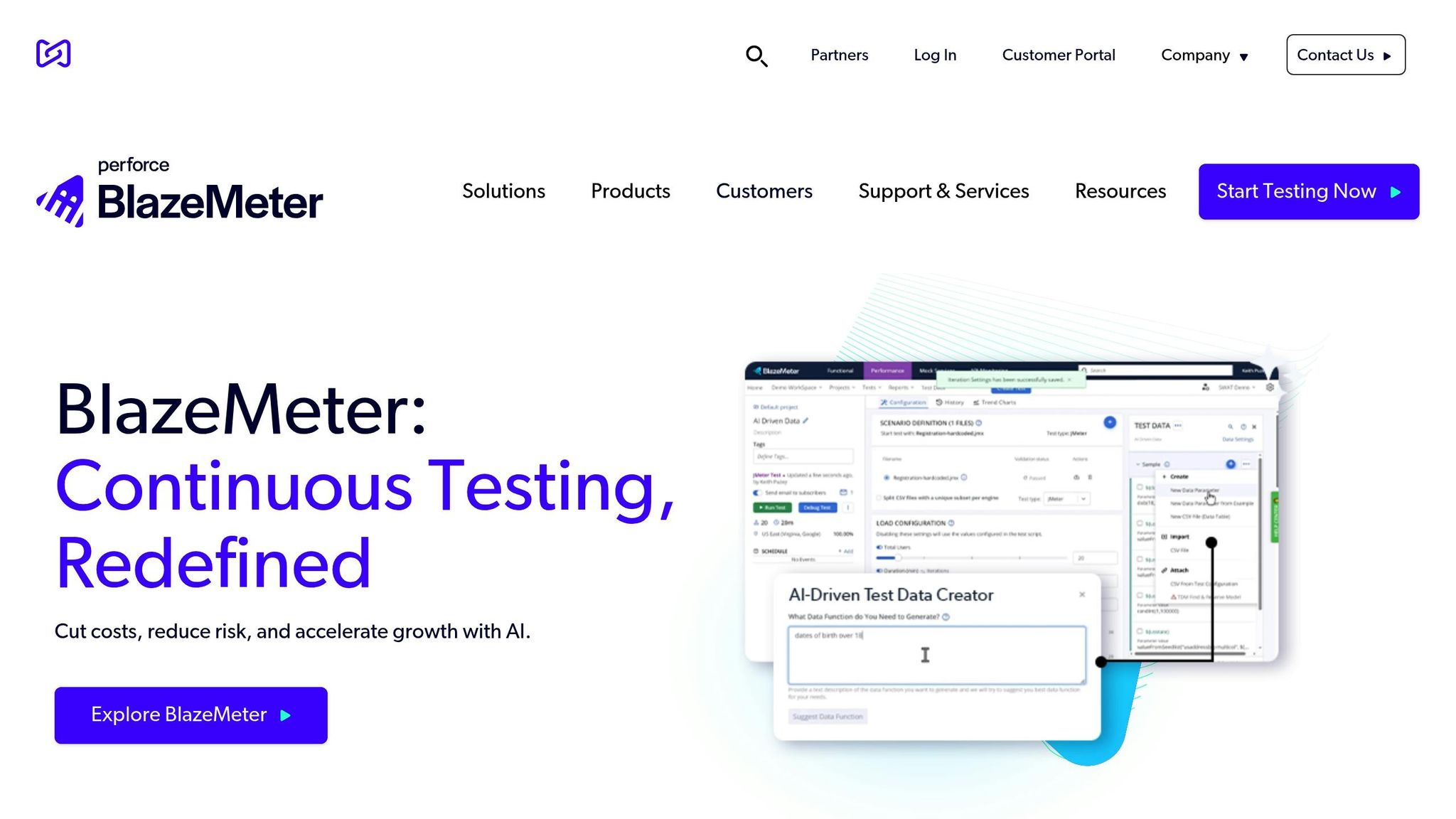
BlazeMeter is a cloud-based performance testing platform designed to ensure applications can handle heavy traffic and operate efficiently before they’re released. Built on Apache JMeter, it scales testing to mimic real-world usage patterns across large, distributed systems.
Platform Support
BlazeMeter expands on performance strategies, such as those used by LeakCanary, by simulating realistic user loads. It supports cross-platform testing for iOS and Android mobile apps, as well as web and API testing. This flexibility allows teams to replicate user behavior and network conditions across various devices and operating systems, making it a versatile tool for diverse mobile environments.
Core Features
BlazeMeter shines when it comes to real-time performance monitoring during simulated load tests. It can generate millions of virtual users to evaluate how mobile apps and backend systems perform under intense traffic. Key metrics like response times, throughput, error rates, and resource usage are tracked, helping teams spot potential issues.
The platform runs JMeter scripts in the cloud, removing the need for local infrastructure. It also offers interactive dashboards and customizable reports, presenting performance data in real time. Reports are easy to share with stakeholders, available in formats like PDF and CSV, and help quickly identify bottlenecks.
While BlazeMeter focuses on load and performance testing, it doesn’t provide crash analytics or direct user experience tracking. Teams looking for detailed crash reports will need to integrate additional tools to fill that gap.
Integration Capabilities
BlazeMeter integrates seamlessly with popular CI/CD tools like Jenkins, Bamboo, and TeamCity through REST APIs. This allows for continuous performance testing during the development and deployment process, catching issues early in the pipeline.
It also connects with analytics platforms like Grafana and Splunk for deeper data analysis. Automated alerts can be set up through Slack and email, ensuring teams stay informed. Additionally, test results can be exported to centralize performance data alongside other operational metrics.
Pricing
BlazeMeter operates on a subscription-based pricing model, billed in USD. It offers a free tier with limited test runs and virtual users, ideal for small teams or trial purposes. Paid plans start at around $99 per month (as of 2025), with pricing based on factors like the number of concurrent tests, virtual users, and access to advanced features. Enterprise plans are available for larger teams, offering higher testing capacities and dedicated support options.
Tool Comparison Chart
After exploring each APM tool's features, this chart breaks down the essential metrics and capabilities to help you make an informed choice.
| Tool | Platform Support | Core Features | Pricing (USD) | Ideal Use Case |
|---|---|---|---|---|
| BrowserStack | Android, iOS | Real device testing (3,500+ devices), session replays, cross-browser testing | From $39/month | Large-scale device/network testing across multiple platforms |
| Appium | Android, iOS, Windows | Cross-platform UI automation, multi-language support (Java, Python, etc.) | Free (open-source) | Automated regression testing with a single codebase |
| New Relic Mobile | Android, iOS | Real-time monitoring, crash analytics, user interaction tracking | From $99/month | Production monitoring and user experience analytics |
| Firebase Performance Monitoring | Android, iOS, Flutter, React Native | Real-user session monitoring, custom traces, automatic performance tracking | Free | Live app usage monitoring with Google ecosystem integration |
| AppDynamics | Android, iOS | End-to-end APM, business transaction tracking, user journey mapping | From $60/month per CPU core | Enterprise-grade monitoring with business impact analysis |
| TestFairy | Android, iOS | Video session recording, beta testing platform, feedback collection | From $49/month | Visual performance analysis and beta testing workflows |
| SolarWinds AppOptics | Android, iOS | Infrastructure monitoring, distributed tracing, customizable dashboards | From $9.99/month per host | Combined infrastructure and app monitoring for SMBs |
| Android Profiler | Android only | CPU, memory, network, battery profiling with Android Studio integration | Free (included with Android Studio) | Development-time debugging and performance optimization |
| LeakCanary | Android only | Automated memory leak detection, detailed leak reports | Free (open-source) | Early memory leak detection during development |
| BlazeMeter | Android, iOS, Web | Load testing, performance analytics, JMeter-based cloud testing | From $99/month | Performance and load testing with CI/CD integration |
The chart above highlights the main differences to guide your decision-making process. Let’s break it down further.
Pricing is a key factor. Free tools like Firebase Performance Monitoring and LeakCanary are ideal for teams with limited budgets, while enterprise-level solutions like AppDynamics provide advanced business insights at a premium.
Platform compatibility is another priority. If your focus is solely on Android, specialized tools like Android Profiler and LeakCanary offer detailed insights tailored to that environment. On the other hand, cross-platform teams can benefit from tools like Appium and BrowserStack, which streamline workflows across multiple operating systems.
When it comes to features, the depth varies significantly. Firebase Performance Monitoring stands out for its easy real-user monitoring, requiring little to no setup. AppDynamics, meanwhile, offers robust business transaction tracking for enterprises, and TestFairy’s video recording capabilities add a unique layer for visual debugging.
For teams in the U.S., tools offering localized features - such as pricing in USD and seamless integration with imperial units and MM/DD/YYYY formats - can make implementation smoother.
Finally, integration capabilities can save time and effort. Tools like Firebase Performance Monitoring and BlazeMeter connect directly with CI/CD pipelines and cloud services, ensuring compatibility with your existing development framework.
Conclusion
Selecting the right APM tool in 2025 is more than just a technical choice - it’s a decision that can directly influence user retention and revenue. With mobile users expecting apps to load in under three seconds, and up to 80% of users uninstalling apps due to poor performance, there’s little room for error.
Different tools cater to different needs: Firebase Performance Monitoring is ideal for teams seeking free, real-user monitoring; AppDynamics provides enterprise-level transaction tracking; and LeakCanary paired with Android Profiler excels at diagnosing Android-specific issues. Each of these tools offers unique strengths that can lead to tangible performance gains.
The benefits of real-time monitoring are undeniable - it can cut downtime by 60% and improve user retention by over 25%, directly impacting business metrics. Companies leveraging these APM solutions have successfully tackled network latency across regions, streamlined user workflows to reduce churn, and lowered support costs by identifying issues before they escalate.
However, implementing and fine-tuning APM solutions isn’t a simple task. Expert teams like Zee Palm, with over a decade of experience and more than 100 completed projects, specialize in turning raw performance data into actionable insights. Their expertise spans industries like AI, SaaS, healthcare, and IoT, making them a valuable partner for optimizing app performance.
As technology continues to advance, integrating the right tools and expertise will remain crucial. Choosing the right APM solutions not only improves user satisfaction and app store ratings but also strengthens a company’s competitive edge and overall success.
FAQs
What should I look for when selecting an APM tool for my mobile app in 2025?
When choosing an APM tool for your mobile app in 2025, it's important to consider factors like core functionalities, cost, and how well the tool fits your app's specific requirements. Look for solutions that offer real-time performance monitoring, proactive issue detection, and insights you can act on to improve your app's performance.
The team at Zee Palm, backed by over 10 years of experience, excels in building custom solutions for AI, SaaS, and app development. Their expertise ensures your app runs smoothly and delivers an outstanding user experience.
How do real-time monitoring and crash analytics in APM tools enhance user experience and boost retention?
Real-time monitoring and crash analytics are essential components in application performance management (APM) tools, helping ensure apps deliver a smooth user experience. These features enable developers to quickly identify and address issues like slow load times, crashes, or bugs, keeping the app running efficiently.
When problems are resolved promptly, users face fewer frustrations, which naturally leads to greater satisfaction and confidence in the app. A dependable, well-functioning app not only keeps users engaged but also boosts retention, encouraging them to stick around for the long haul.
Are free APM tools like Firebase Performance Monitoring and LeakCanary enough for small development teams?
Free APM tools like Firebase Performance Monitoring and LeakCanary can be excellent options for small development teams. They’re particularly useful for spotting performance bottlenecks and identifying memory leaks in mobile apps. For teams working with limited budgets or straightforward needs, these tools can serve as a solid starting point.
That said, getting the most out of these tools requires experienced developers who know how to integrate them seamlessly into your workflow. Developers with expertise in areas like AI, SaaS, and custom app development can ensure these tools are used effectively, helping you fine-tune your app’s performance and reliability.




